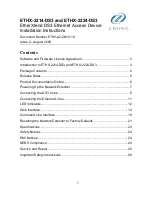
The switch must have at least one blocked port.
•
The failure must be on the root port.
•
If a link fault occurs on the primary root link, UplinkFast transitions the blocked port to a forwarding state.
UplinkFast changes the port so that it bypasses the listening and learning phases. This change occurs in three
to four seconds, allowing convergence to begin immediately without waiting for the MaxAge timer to expire.
Note UplinkFast becomes a global setting on the switch. It affects all the VLANs on the switch and cannot be
applied on just one VLAN. When you enable UplinkFast, it automatically increases the path cost,
making it unlikely that the switch will become the root switch. If UplinkFast is not being used, you
should use the Catalyst default settings.
BackboneFast
BackboneFast is a function that allows the switch to converge more quickly in the event that a redundant link
fails. An inferior BPDU is sent when a link from the designated switch has been lost to the root bridge. When
the root port or a blocked port on a switch receives an inferior BPDU from its designated bridge, if
BackboneFast is enabled, this event in turn triggers a root Link Query.
The designated switch transmits these BPDUs with the new information that it is now the root bridge as well
as the designated bridge, and the BPDUs begin arriving on a port that is blocked on the switch. The switch
receiving inferior BPDUs will ignore the message until the configured MaxAge timer expires, to give the
network time to overcome the network problem.
If inferior BPDU messages continue to arrive after the MaxAge timer has been used, the root port and other
blocked ports on the switch become alternate paths to the root bridge. The switch will send another kind of
BPDU called the root Link Query PDU if more than one link exists to the root bridge. The switch will send a
root Link Query PDU out all the available alternate paths to the root bridge to determine which one will
forward.
If there are no other blocked ports, the switch automatically assumes that it has lost connectivity to the root
bridge, causes the maximum aging time on the root to expire, and becomes the root switch. BackboneFast
must be enabled on all switches in the network in order to function properly.
Tip BackboneFast cannot be used in a Token Ring network.
Enabling STP on a Set/Clear Command−Based Switch
The Set/Clear command−based switch allows you to enable and disable STP on a per−port basis. Every port
on the switch is enabled for STP by default. If STP has been disabled on the switch, you can re−enable STP
from the Privileged mode prompt.
Note Cisco recommends that STP remain enabled on the switch. It is important that it remain enabled on any
trunk port where the possibility exists of a bridging loop in the network.
To enable STP on a Set/Clear command−based switch, use the following Privileged mode command:
catalyst5000> (enable) set spantree enable
After using this command you must use the set spantree enable all command to enable STP on all the
VLANs. An example is shown in the next section.
212
Summary of Contents for Catalyst 1900 Series
Page 1: ......















































